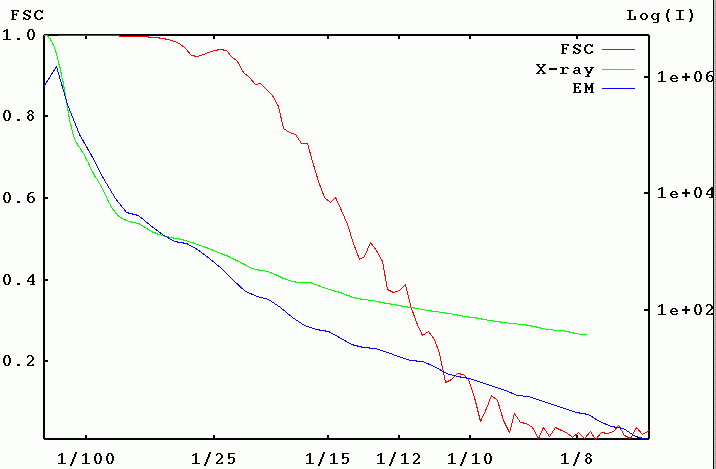
Enhance the Fourier amplitudes of a reconstructed cryo-EM volume
such that they more closely resemble those of experimental
low-angle X-ray scattering data.
This approach is described in Gabashvili et al., Cell 100:537-549, March 3, 2000.

EM : 1D power spectrum of EM volume.
X-ray : Low-angle of X-ray scattering data, out to 8 Å.
FSC : Fourier shell correlation of the
EM volume. The Fourier amplitudes need only be corrected out to
the spatial frequency corresponding to the 0.5 FSC level, here 1/14 Å.
The above data were plotted with a gnuplot script. The EM data were first multiplied to be in the same numerical range as the X-ray data (right axis), by running the procedure b06.pww.
These data are in the form of SPIDER document files with 4 columns:
| Frequency (1/Å) | intensity multiplied by 60 | (unknown) | frequency in units of 2.93 Å |
| Inputs: | volume to be enhanced, |
| X-ray scattering data | |
| Outputs: | 1D power spectrum from volume, |
| enhancement curve |
gnuplot> K(x)=A*x*x+B gnuplot> fit K(x) 'fen.dat' using 1:3 via A,B gnuplot> plot 'fen.dat' using 1:3 with lines, K(x) A = 623.42 +/- 20.02 (3.212%) B = 13769.2 +/- 1.153e+04 (83.72%)Or, you can try a 3 parameter expression for a better fit:
gnuplot> K(x)=C*x*x*x+A*x*x+B gnuplot> fit K(x) 'fen.dat' using 1:3 via A,B,CGnuplot script to save parameters to a file, and plot the curves in a gnuplot window.
applyabc.bat using the parameters obtained above, apply the enhancement/correction to the volume, then filter the volume at the resolution level.
applyfen.bat Alternatively, apply the enhancement curve directly to the volume.